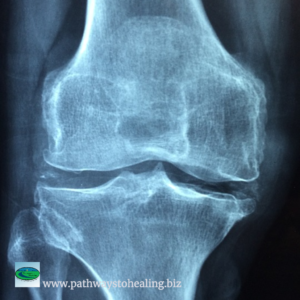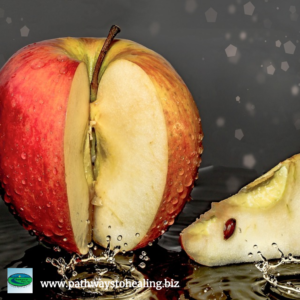By: Dr. Alyssa Musgrove – Pathways to Healing
As many as 54 million Americans have low bone density, and many of them don’t even know it. Ten million Americans have such low bone density they actually have osteoporosis.
 Osteoporosis is a bone disease that occurs when the body loses too much bone, makes too little bone, or both. Advanced osteoporosis usually presents with symptoms such as bone pain, backache, curvature of the upper spine presenting as a hump, and loss of height from vertebral compression fractures.
Osteoporosis is a bone disease that occurs when the body loses too much bone, makes too little bone, or both. Advanced osteoporosis usually presents with symptoms such as bone pain, backache, curvature of the upper spine presenting as a hump, and loss of height from vertebral compression fractures.
However, osteopenia (characterized by low bone mineral density that is not extreme enough to be called osteoporosis) and early-to-middle stages of osteoporosis are silent diseases that have no symptoms. A diagnosis of osteopenia or osteoporosis is often found accidentally, such as when a bone is being x-rayed to determine the existence of a fracture. Typically, when low bone mass shows up on an x-ray, as much as one-third of the person’s bone mass has already been lost.
You could be at risk for low bone density and osteoporosis if you:
- Are a woman – especially if you’ve had a hysterectomy or are postmenopausal
- Are over 50 years old
- Have an inactive lifestyle
- Have amenorrhea because of extreme exercise
- Have a history of an eating disorder or under-eating for many years
- Are a heavy user of alcohol, tobacco, caffeine, sugar or carbonated beverages
- Have a chronic health disorder such as diabetes, malabsorption condition, celiac disease, or hyperthyroidism
- Are small-boned and consistently below normal weight for someone your size
- Are, or have a history of, taking certain prescription medications long-term, such as steroids (cortisone and prednisone), certain birth controls and anticonvulsants
- Have a history of cancer treatments, including chemotherapy or radiation
- Are deficient in certain key nutrients, including vitamin D, vitamin K, calcium and magnesium
- Have a low level of testosterone – even if you are a woman
- Have a family history of osteoporosis, fractures or bone disorders
The only way to truly detect the bone loss associated with osteopenia is with a bone scan – most commonly a low-radiation DEXA scan (Dual-Energy X-ray Absorptiometry) of the hip and spine. A bone scan can detect even small changes in a person’s bone density.
Our bodies are constantly making new bone, however, as we age, we tend to start losing more bone than we create. The good news is, it’s never too late to focus on bone health. Here are a few simple ways you can help increase your bone density naturally:
 Exercise – Exercise, especially “weight-bearing” types, is needed to keep muscles strong, sustain skeletal strength and help maintain bone density. Weight-bearing exercises include any type of exercise that forces you to work against gravity. Weight-bearing exercises require your bones and muscles to support your body weight, while also enhancing coordination and balance. (Coordination and balance are important for preventing the slips, falls and accidents that wind up causing a serious fracture or injury.) Examples of weight-bearing activities include walking, dancing, yoga, skiing, tennis, body weight exercises using resistance bands/cables, or even lifting soup cans. Aim to do weight-bearing exercises at least 3 to 4 times per week for 30-60 minutes in duration.
Exercise – Exercise, especially “weight-bearing” types, is needed to keep muscles strong, sustain skeletal strength and help maintain bone density. Weight-bearing exercises include any type of exercise that forces you to work against gravity. Weight-bearing exercises require your bones and muscles to support your body weight, while also enhancing coordination and balance. (Coordination and balance are important for preventing the slips, falls and accidents that wind up causing a serious fracture or injury.) Examples of weight-bearing activities include walking, dancing, yoga, skiing, tennis, body weight exercises using resistance bands/cables, or even lifting soup cans. Aim to do weight-bearing exercises at least 3 to 4 times per week for 30-60 minutes in duration.
Eat a Bone-Healthy Diet – Focus on eating bone-healthy foods that are high in vitamin D, vitamin K, calcium and magnesium. Incorporate a variety of green leafy vegetables like kale, bok choy, broccoli, and cabbage. (Spinach should be avoided as a source of calcium, because it is high in oxalates that bind calcium.) Fish, such as sardines with small, edible bones, are an excellent source of calcium and oily fish, especially wild-caught salmon, are a good source of vitamin D. Other great sources of magnesium and calcium include: almonds, sesame seeds/sesame butter, beans and legumes, avocadoes, and dark chocolate.
 Keep in mind that while eating foods high in vitamin D, vitamin K, calcium and magnesium is encouraged, it can be difficult to get the ideal amounts from your diet alone. This is primarily because the amounts of these nutrients in foods can vary widely. For example, a study of the vitamin D content of salmon found an average of only 240 IU of Vitamin D3 in farmed salmon compared to an average of 988 IU vitamin D3 in 3.5 ounces of wild-caught salmon.
Keep in mind that while eating foods high in vitamin D, vitamin K, calcium and magnesium is encouraged, it can be difficult to get the ideal amounts from your diet alone. This is primarily because the amounts of these nutrients in foods can vary widely. For example, a study of the vitamin D content of salmon found an average of only 240 IU of Vitamin D3 in farmed salmon compared to an average of 988 IU vitamin D3 in 3.5 ounces of wild-caught salmon.
Optimize Vitamin D Levels – Vitamin D helps the body improve calcium absorption. Spending most of your time indoors and avoiding the sun may mean that your body isn’t making the vitamin D it needs to help maintain bone mass.
It is best to obtain Vitamin D naturally by exposing your bare skin to sunlight for about 15-20 minutes every day.
If you are at high risk for osteopenia or osteoporosis, talk to your doctor about having a bone density test (DEXA) and check your vitamin D levels. No matter the current state of your bone health, incorporating these simple tips today can help you prevent fractures or complications in the future.
 Pathways to Healing specializes in holistic chiropractic care. Dr. Alyssa Musgrove draws on a variety of techniques, including chiropractic, kinesiology, nutrition, food allergy testing and lifestyle counseling to assist clients in achieving optimal health and wellness in one setting. Pathways to Healing is located at 1022 Founders Row, Lake Oconee Village, Greensboro. The office can be reached at 706-454-2040.
Pathways to Healing specializes in holistic chiropractic care. Dr. Alyssa Musgrove draws on a variety of techniques, including chiropractic, kinesiology, nutrition, food allergy testing and lifestyle counseling to assist clients in achieving optimal health and wellness in one setting. Pathways to Healing is located at 1022 Founders Row, Lake Oconee Village, Greensboro. The office can be reached at 706-454-2040.

